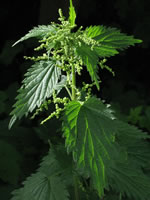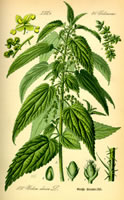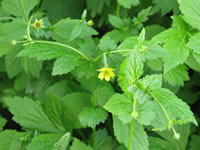June 2013
Nettles
30/06/13 14:21
Large crops of nettles on the lane, mostly of the stinging variety rather than the similar (but unrelated) dead-nettles. They are strategically placed to block access to the raspberries… Both common species of nettle, the common nettle and the small nettle, are represented.


As well as protecting raspberries, nettles are used in making tea or soup, with the new shoots said to be particularly flavoursome. The sting inactivates on cooking. It is said to be high in protein, vitamins and minerals, particularly iron. It is also said to be diuretic.
They act as a habitat for a large number of insects, butterfly larvae and bees.
Nettles are naturally fire-resistant, a property which has been utilised in the manufacture of chemical-free fabrics for commercial premises. Apparently one of the limiting factors is the reliable supply of nettles.
National nettle week is in May - missed it this year!


As well as protecting raspberries, nettles are used in making tea or soup, with the new shoots said to be particularly flavoursome. The sting inactivates on cooking. It is said to be high in protein, vitamins and minerals, particularly iron. It is also said to be diuretic.
They act as a habitat for a large number of insects, butterfly larvae and bees.
Nettles are naturally fire-resistant, a property which has been utilised in the manufacture of chemical-free fabrics for commercial premises. Apparently one of the limiting factors is the reliable supply of nettles.
National nettle week is in May - missed it this year!
bats
22/06/13 18:57
I knew there were bats in the area because we have had pipistrelles in the house before and local dog walkers see them regularly in the evening, so I set out about 10 days ago armed with a bat detector and found…nothing.
Exploring another evening there were bats to be heard on the detector at 45 Hz in the field, over Marl Pits and along Conway Road up to Balladen brook. 45HZ is the frequency for the common pipistrelle but also for some other bat species.
So last Wednesday armed with bat detector and warm drink we sat in the garden for an hour from sunset (21.40) and saw and heard loads. They were mainly flying over Sunset View, the Cot and Springhill Cottage to and from the Paddock/New Croft Meadow. I didn’t see any emerging from the west of any of these properties so suspect the roost was elsewhere.
A quick wander between Rose Cottage/Polefield and the new houses on the site of Springhill Farm showed it to be bat alley, with mainly pipistrelles flying along that corridor. Lots in the area behind Springhill Cottage - are they roosting there? If so, then they have nesting house sparrows in the southwest and roosting bats in the northeast.
Whilst most bats seen were common pipistrelles there were other species around, some of which did not register at 45Hz. Not sure what they were as they were only seen fleetingly.
edit 23 June - there are definitely some pips roosting under Springhill Cottage roof.
Exploring another evening there were bats to be heard on the detector at 45 Hz in the field, over Marl Pits and along Conway Road up to Balladen brook. 45HZ is the frequency for the common pipistrelle but also for some other bat species.
So last Wednesday armed with bat detector and warm drink we sat in the garden for an hour from sunset (21.40) and saw and heard loads. They were mainly flying over Sunset View, the Cot and Springhill Cottage to and from the Paddock/New Croft Meadow. I didn’t see any emerging from the west of any of these properties so suspect the roost was elsewhere.
A quick wander between Rose Cottage/Polefield and the new houses on the site of Springhill Farm showed it to be bat alley, with mainly pipistrelles flying along that corridor. Lots in the area behind Springhill Cottage - are they roosting there? If so, then they have nesting house sparrows in the southwest and roosting bats in the northeast.
Whilst most bats seen were common pipistrelles there were other species around, some of which did not register at 45Hz. Not sure what they were as they were only seen fleetingly.
edit 23 June - there are definitely some pips roosting under Springhill Cottage roof.
on buttercups
15/06/13 13:07
I recall from secondary school biology being taught how to use a Linnaeus key by identifying a meadow buttercup. Little did I know then that there are over a couple of dozen members of the buttercup family in Britain, with some of them looking nothing like the yellow flower which glows when you put it under the chin…
There are at least three species of buttercup on the lane:
meadow buttercup (Ranunculus acris)
goldilocks buttercup (Ranunculus auricomus)
creeping buttercup (Ranunculus repens)
amongst them, and looking for all the world like a buttercup at first glance was wood avens or Genum urbanum. Except that it isn’t a buttercup at all, its a member of the rose family. It is said to protect against rabid dogs and venomous snakes - thankfully neither of these has been identified on the lane to date. The roots have also been used to flavour beer with a flavour akin to cloves.


There are at least three species of buttercup on the lane:
meadow buttercup (Ranunculus acris)
goldilocks buttercup (Ranunculus auricomus)
creeping buttercup (Ranunculus repens)
amongst them, and looking for all the world like a buttercup at first glance was wood avens or Genum urbanum. Except that it isn’t a buttercup at all, its a member of the rose family. It is said to protect against rabid dogs and venomous snakes - thankfully neither of these has been identified on the lane to date. The roots have also been used to flavour beer with a flavour akin to cloves.


| Culpepper describes it as follows: |
an absence of cuckoos
08/06/13 10:26
Usually seasons are announced by the arrival of things - snowdrops, swallows, falling leaves, shortening days and the like. These can be dated and years compared by the date the first blackbird sang or first swallow arrived.
Sometimes though seasons are noted by the absence of things with which they were once associated. Of these the most notable is the cuckoo, an April regular during my childhood but not heard round here for many years now.
Another of these is clover, once commonplace but now much less so, and coltsfoot which was everywhere but not been seen for ages either. Ragwort is still common but cinnabar moth caterpillars have declined.
I have no data to back these up, just my reflections. But I haven’t heard a cuckoo round here for years.
Sometimes though seasons are noted by the absence of things with which they were once associated. Of these the most notable is the cuckoo, an April regular during my childhood but not heard round here for many years now.
Another of these is clover, once commonplace but now much less so, and coltsfoot which was everywhere but not been seen for ages either. Ragwort is still common but cinnabar moth caterpillars have declined.
I have no data to back these up, just my reflections. But I haven’t heard a cuckoo round here for years.
weeds?
02/06/13 20:33
Not seen many bees since the queen buff taileds were looking for places to nest a few weeks ago. A number of butterflies are beginning to be seen, particularly Peacocks, small tortoiseshell and green-veined whites. Other flying visitors included the Common aeshna dragonfly, the common gnat and the midge.
Herb-robert now out on the lane, as are the buttercups, dandelions and daisies. The hybrid bluebells are up in force now as is the bittercress.
I have just signed up for the plantlife survey and whilst my patch is a couple of km from here I intend to use the same methodology to study the lane as a wildflower path and part of the paddock/New Croft Meadow as a wildflower patch. A quick scan over the former suggests that it will be mainly ash seedlings, buttercups and the common nettle but we will see.
The owl is back :)
Herb-robert now out on the lane, as are the buttercups, dandelions and daisies. The hybrid bluebells are up in force now as is the bittercress.
I have just signed up for the plantlife survey and whilst my patch is a couple of km from here I intend to use the same methodology to study the lane as a wildflower path and part of the paddock/New Croft Meadow as a wildflower patch. A quick scan over the former suggests that it will be mainly ash seedlings, buttercups and the common nettle but we will see.
The owl is back :)




